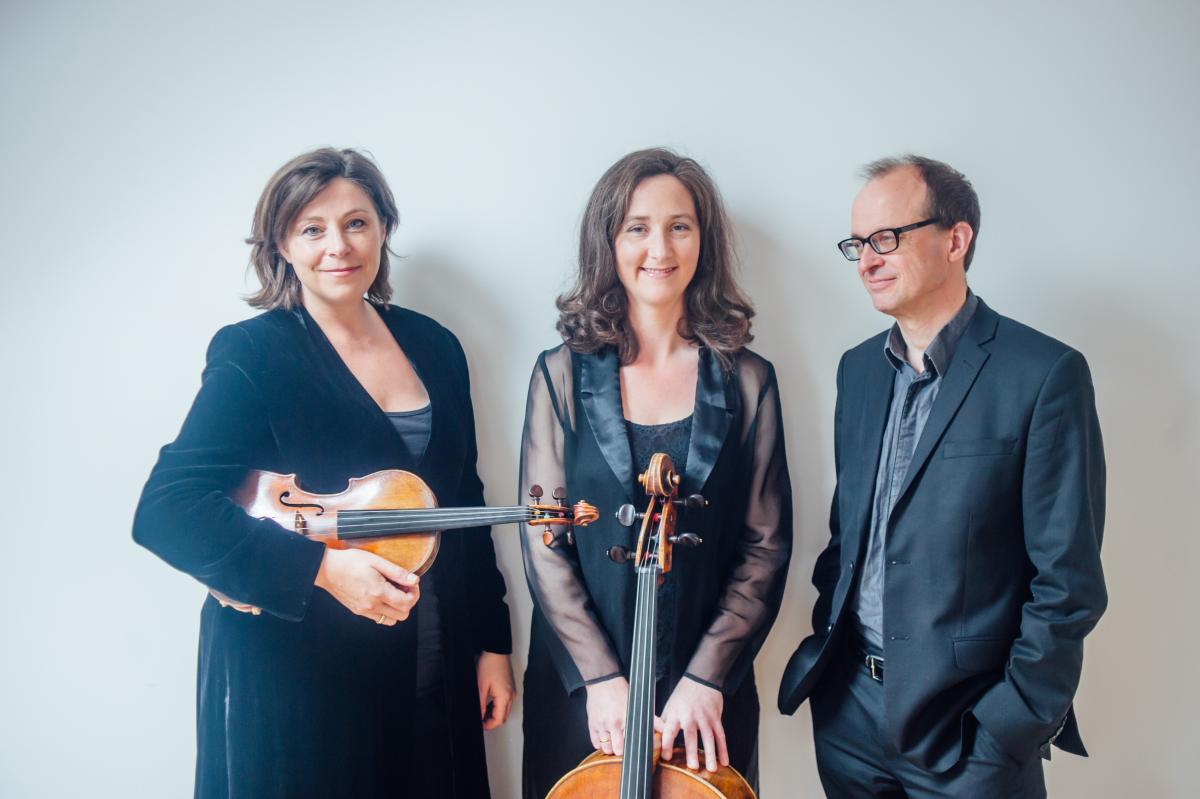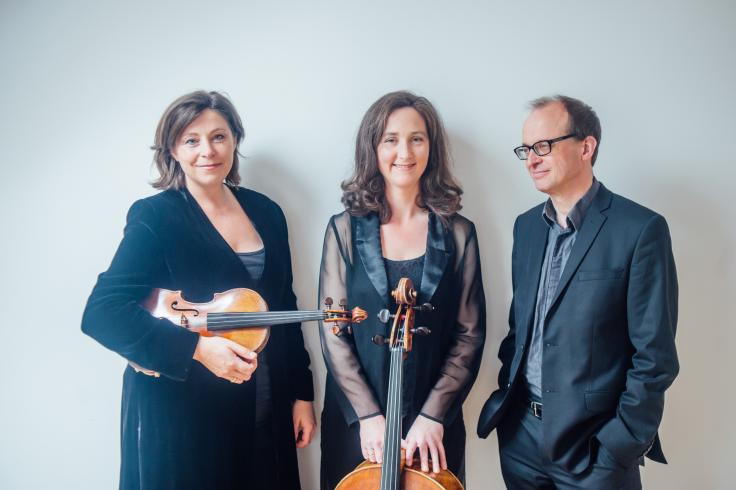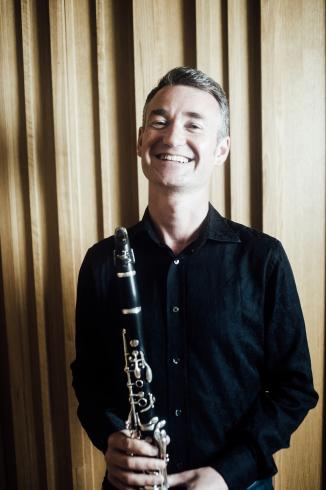Gould Piano Trio & Robert Plane
Piano Trio and Clarinet

The British Gould Piano Trio, and clarinetist Robert Plane will perform selections by Beethoven, Bartók, and Brahms.
Program
The Gould Piano Trio celebrates its 25th anniversary together in 2017. This British ensemble has long been recognized as one of the most outstanding piano trios (The Washington Post likened it to the Beaux Arts Trio), and these musicians have a close artistic relationship with celebrated clarinetist Robert Plane. Widely praised for its enterprising rediscovery of neglected repertoire, the trio has also recorded complete cycles of Beethoven and Brahms. This program includes Bartok’s Contrasts, originally written for the composer himself to play with Benny Goodman and Joseph Szigeti, and the most resplendent of Brahms’s piano trios.
PROGRAM:
LUDWIG VAN BEETHOVEN (1770-1827)
Trio in B-flat Major, Op. 11 for Clarinet, Cello, and Piano (1797)
Allegro con brio
Adagio
Theme and Variations: Allegretto
BÉLA BARTÓK (1881-1945)
Contrasts for Clarinet, Violin, and Piano, Sz. 111, BB 116 (1938)
Verbunkos (Recruiting Dance)
Pihenö (Relaxation)
Sebes (Fast Dance)
Intermission
JOHANNES BRAHMS (1833-1897)
Piano Trio No.2, Op.87 in C major (1880)
Allegro
Andante con moto
Scherzo. Presto
Finale. Allegro giocoso
About the Artists
The Gould Piano Trio, recently compared to the great Beaux Arts Trio for their “musical fire” and dedication to the genre in the Washington Post, have remained at the forefront of the international chamber music scene for well over twenty years. Having been launched by their first prize at the Melbourne International Chamber Music Competition and subsequently selected as YCAT artists, they made tours in Europe and the US as “Rising Stars,” making a highly successful debut at the Weill Recital Hall, described by Strad Magazine as “Pure Gould.” In recent years they have developed a close relationship with London’s Wigmore Hall, performing all the Dvorak Trios in a Czech Series, giving a recital in the BBC Radio 3 lunchtime series and now looking forward to their Beethoven Trios cycle in the 2017/2018 season. At St. George’s, Bristol, they performed and recorded these trios live for Somm, arguably the pinnacle of the repertoire, and also brought a concentrated intensity for players and listeners alike in performances of the Schumann trios and Brahms Piano Quartets.
Their discography not only includes the renowned masterpieces of the repertoire, but many hidden gems, brought to life through an on-going collaboration with that great musical pioneer, clarinetist, Robert Plane. Trio cycles by Beethoven (Somm), Brahms (Quartz), Hummel (Naxos), and Dvorak (Champs Hill) have been complemented by the late romantic works of C.V. Stanford, John Ireland, Robin Milford, Cyril Scott, and Arnold Bax. A recording of contemporary works by Maxwell-Davies, Beamish, and MacMillan (Champs Hill) was released last year, helping to bring British music, and many world premiere recordings to an international public. This year, however, will see the release of the complete Piano Quartets of Brahms plus his friend, Theodor Kirchner’s transcriptions of the master’s String Sextets for piano trio—another exciting rarity. Through their annual festivals in Corbridge, Northumberland, now in its 18th year, and Cardiff at the RWCMD, where they are Artists in Residence and recently made Fellows, the trio take inspiration from playing a wide range of chamber music with colleagues and coaching aspiring young ensembles. Giving masterclasses in Dartington Hall and Aldeburgh have been rewarding ways of passing on their years of experience. The Trio has been given the opportunity, as Artistic Directors of the 2017/2018 Leeds International Chamber Season, to curate a series of six concerts throughout the season. They will perform along with invited artists, works from pre-revolution Russia to mark the 100th anniversary of the historic Russian revolutions of that year.
The trio has been keen to commission new works; recently Sir James MacMillan’s second Piano Trio, premiered to much acclaim at the Bath International Festival in 2014, and looking towards the 2016 season and beyond, works from Simon Rowland-Jones, Mark Simpson and Huw Watkins have been commissioned. The trio are particularly delighted that the Simpson is part of the “Beyond Borders” PRS scheme and has also been chosen for the New Music Biennial in Hull and at the South Bank, London, as part of the City of Culture celebrations in 2017, a fitting way to mark the 25th anniversary of the Gould Piano Trio.
Robert Plane won the Royal Over-Seas League Music Competition in 1992. Since then his solo and chamber career has taken him to prestigious venues across Europe and beyond, performing Mozart’s Clarinet Concerto in Madrid’s Auditorio Nacional de Musica with the City of London Sinfonia, on tour in the US with the Virginia Symphony and throughout China with the BBC National Orchestra of Wales, during which his performance at Beijing’s National Centre for the Performing Arts was broadcast live to a TV audience of ten million.
Plane has become particularly known for his performances and recordings of the magnificent English repertoire for clarinet. Gramophone magazine has praised playing of “ravishing lyricism and conviction by Robert Plane, who has now surely fully occupied the shoes of the late Thea King in his championship of British clarinet music.” His benchmark recording of Finzi’s Clarinet Concerto (BBC Radio 3 Building a Library recommendation and part of the Naxos British Music Series which won a Gramophone Award in 1999) is still a regular feature of the playlists of both Radio 3 and Classic FM nearly twenty years after its initial release.
Plane made his solo debut at the BBC Proms in 2011 in Simon Holt’s double concerto “Centauromachy.” He gave the world premiere of Piers Hellawell’s “Agricolas,” with subsequent performances and a recording for Delphian with the Ulster Orchestra and the RTE National Symphony Orchestra. Other notable premieres include the clarinet concerto by Diana Burrell, with performances with Royal Northern Sinfonia at the Huddersfield Contemporary Festival and at the Barbican, and Nicola LeFanu’s Concertino.
Plane has formed close partnerships with a number of leading chamber ensembles. He has performed and recorded with the Gould Piano Trio for over twenty years and their recording of Messiaen’s Quartet for the End of Time was hailed by Gramophone as the “finest modern version” of this monumental work. He also appears on the Gould Trio’s recorded cycle of the complete trios of both Beethoven and Brahms. Together they direct the Corbridge Chamber Music Festival in Northumberland. He has collaborated with the Maggini, Dante, Auer, Carducci, Cavalleri, Brodsky, and Tippett Quartets, and his performance of the Brahms Clarinet Quintet with the Skampa Quartet was broadcast live on Radio 3 on the opening night of that station’s “Brahms Experience.”
Alongside his solo and chamber work Robert has held the position of principal clarinet with Royal Northern Sinfonia, the City of Birmingham Symphony Orchestra, and BBC National Orchestra of Wales. He has played as a guest principal with the Royal Concertgebouw, the London Symphony Orchestra, and the Chamber Orchestra of Europe.
Plane teaches at the Royal Welsh College of Music and Drama. He has given masterclasses at the Royal College of Music, Trinity Laban, Birmingham Conservatoire, Beijing Conservatoire, and the San Francisco Conservatory.
This year Plane will tour the US with the Gould Piano Trio and make his debut performance in Washington, DC at The Phillips Collection. Another highlight of 2017 will be the release of a new recording, Contrasts, for Champs Hill Records, featuring music from Hungary by Bartok, Serly, Dohnanyi, Weiner, Rozsa, and Kurtag.
Notes
Ludwig van Beethoven, Trio for Clarinet, Cello, and Piano in B-flat Major, Op. 11 (1797)
Beethoven’s Trio Op. 11, sometimes known as the Gassenhauer (“Popular Tune”) Trio, was composed between the end of 1797 and the summer of 1798. It was published in October 1798 by the Viennese firm of Tranquillo Mollo, an edition which describes it as “for the pianoforte, clarinet or violin and violoncello.” The tune that led to the work’s nickname was taken from the opera L’amor marinaro ossia Il corsaro by the Viennese composer Joseph Weigl (1766–1846). The opera was first performed at the Burgtheater on October 15, 1797 and it remained in the repertoire until 1805. The melody Beethoven used for the third movement (Pria ch’io l’impegno–“Before I go to work”) was particularly popular and other composers (including Hummel and Paganini) used it as a subject for variations.
The Trio was dedicated to Wilhelmine Countess of Thun-Hohenstein (1744–1800), one of the grandest Viennese aristocrats of the time and also an accomplished musician in her own right. She may well have taken some lessons with Haydn and her harpsichord playing was praised by Charles Burney when he visited Vienna; he wrote that “she possesses as great skill in music as any person of distinction [aristocrat] I ever knew.” Countess Wilhelmine had already been a patron of Haydn and Mozart, and her encouragement of the young Beethoven enabled him to make his way in Vienna’s aristocratic circle of potential musical patrons. Several members of the Thun family are listed as subscribers for Beethoven’s Piano Trios Op. 1, and two of the Countess’s daughters married important Beethoven patrons: Maria Elisabeth (1764–1806) was married to Count (later Prince) Razumovsky and Maria Christiane (1765–1841) to Prince Karl von Lichnowsky.
This trio is the only one of Beethoven’s large-scale instrumental works to include a set of variations on a theme by another composer and Beethoven later told Czerny that he planned to write a substitute finale (though he never did so). Given the description on the title page of the first edition, it is likely that Beethoven intended the trio to be played by either clarinet or violin and accordingly he wrote a part that could suit either instrument. Cast in three movements, the first is in Sonata form, the second is a song-like Adagio (its main theme introduced by the cello before being taken up by the clarinet), and the finale is the charming set of nine variations on Weigl’s theme. When it appeared in print, the Trio was reviewed in the Allgemeine musikalische Zeitung, its critic suggesting that here might be a young composer of promise: “This Trio is by no means easy, but it runs more flowingly than much of the composer’s other work, and produces an excellent ensemble effect. If the composer, with his unusual grasp of harmony, his love of the graver movements, would aim at natural rather than strained or recherché composition, he would be able to set good work before the public, and these would throw into the shade the stale, hurdy-gurdy tunes of many a more talked-about musician.”
Béla Bartók, Contrasts for Clarinet, Violin, and Piano, Sz. 111, BB 116 (1938)
In August 1938, the violinist, Joseph Szigeti, wrote to Bartók that he had been visited by Benny Goodman (describing him as “the world-famous jazz clarinet idol”) and that they had discussed commissioning a new work for which Bartók would be paid $300. It should, Szigeti wrote, be for clarinet and violin with piano, lasting “approx. 6–7 minutes…If possible it would be great if it is composed of two independent parts, and we hope that a brilliant clarinet and violin cadenza will be included too!” The plan for two independent sections was almost certainly with a view to stamping each movement on to a single side of a 78 rpm. record. Bartók got to work quickly, and the two-movement version of the piece, called Rhapsody, was finished by September 24, 1938. A few weeks later, Bartók added a central slow movement, which he called Pihenö (Relaxation) and the whole work was finished by October 9. The world premiere of the two-movement version was given by Szigeti, Goodman, and the pianist Endre Petri at Carnegie Hall on January 9, 1939. It was reviewed in the next day’s New York Times where it was described as “Bartók’s new Rhapsody.” The critic wrote that “the Hungarian composer has taken some of the most earthy and boisterous tunes of his native peasantry, decorated them with garlands of improvisational cadenzas and spiced them with the rollicking rhythms of rude, stamping feet and whirling skirts…The work is as Hungarian as goulash.” Bartók visited the US (for the first time since 1928) from April–May 1940 to give recitals with Szigeti, including a celebrated concert at the Library of Congress on April 13, 1940 (the recording of which was added to the National Registry in 2002). During this trip Bartók also gave the first complete performance of Contrasts in its definitive three-movement version (and with its correct title) at Carnegie Hall on April 21, with Szigeti and Goodman. A few weeks later, on May 13, this extraordinary trio of performers recorded the work for Columbia Records (produced by Goddard Lieberson). In October 1940, the deteriorating situation in Europe led Bartók and his wife to immigrate to the United States, and a month later the recording of Contrasts was published. Reviewing it in the New York Times, Howard Taubman was full of praise for the work and the performance. All three movements “have the mark of the mature Bartók; they are crisp, clean-cut and audacious. Mr. Bartók finds new colors and harmonic combinations for his instruments, writing for them with persuasive relish. He makes the most of the virtuosity of his instrumentalists, and they the most of the opportunities he offers them. The result is not merely a technical tour-de-force, but a diverting and freshly conceived composition.”
The first movement is a stylized version of a Hungarian “Recruiting Dance,” moderately fast, originally a little formal, the dotted rhythms of its melody now decorated with embellishments. In the central part of the movement the piano starts to imitate the sound of a cimbalom, before a recapitulation of the opening material that is interrupted by a brilliant cadenza for the clarinet. The central slow movement opens with the violin and clarinet playing an intertwined melody, each taking the upper line in turn, leading to a restless central section before returning to the music that started the movement, but with the theme now in the piano. The finale is fast and furious, and requires the violin to be retuned (to G sharp, D, A, and E-flat), an effect heard right at the start before the clarinet introduces the main theme. A central section drawing on the complex rhythms of Bulgarian folk music leads to a reprise of the opening, the tempo increasing all the time until the music seems to collapse in a delighted heap, exhausted but elated.
Johannes Brahms, Piano Trio No. 2 in C Major, Op. 87 (1880)
Brahms composed the first movement of the C Major Piano Trio at Bad Ischl in Austria’s Salzkammergut region in June 1880. Two years later, in June 1882, he completed the rest of the trio in the same location: it was always one of the composer’s favorite spots, where he was able to compose in peace. The other works to emerge from the 1880 visit were Brahms’s two concert overtures: the Academic Festival Overture and the Tragic Overture, and when he returned in 1882, his summer produced not only the other three movements of the C Major Trio, but also the String Quintet Op. 88 and the Song of the Fates Op. 89 for chorus and orchestra. As was Brahms’s usual custom with his chamber music, he sent manuscript copies of the new Trio to close friends including Theodor Billroth and Clara Schumann (who tried it out with friends on several occasions, at least one of which Brahms heard), and Brahms himself gave a private performance in the village of Altaussee on August 25, 1882. The public premiere followed at the end of the year: in Cologne on December 14 and in Frankfurt on December 29, with the composer at the piano on both occasions.
Brahms’s earlier Trio in B Major (Op. 8) was a rhapsodic work that he was to revise extensively in 1889, but the C Major Trio shows the composer in a much more concise frame of mind. Brahms himself was delighted with the work, writing to his publisher, Simrock: “You have not yet had such a beautiful trio from me and very likely have not published its equal in the last ten years!!!” The striding opening theme—first heard in octaves on the violin and cello—has a strong sense of rhythmic energy that is used to propel much of the first movement. The Andante con moto similarly opens with a theme in octaves on the strings, but this time it’s a plangent melody in the minor, which becomes almost defiant at the movement’s climax. The ghostly Scherzo is complemented by a radiant swaying theme in the central Trio section. The main theme of the finale is marked by the use of a sharpened fourth note of the scale (F-sharp in C Major) that gives it a particular character, and this memorable tune drives the movement to a jubilant conclusion.
Nigel Simeone, 2017

